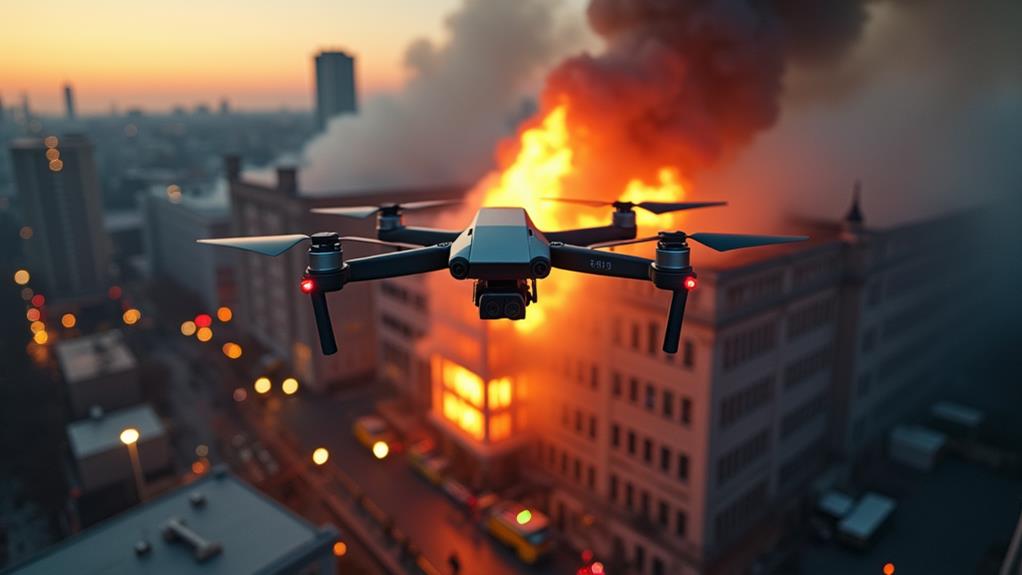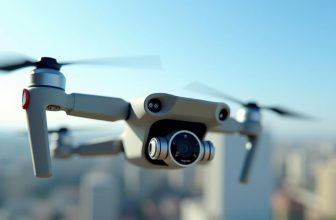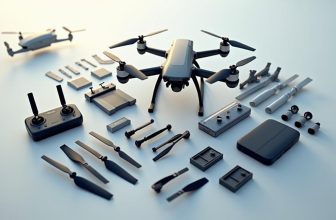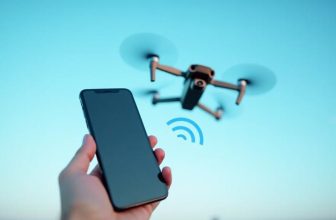
You might be surprised to learn that drones have been successfully utilized within public safety operations for over a decade, with some fire departments and police forces having implemented them as early as 2010. As you contemplate the potential of drones within this framework, it's worth noting that these unmanned aerial vehicles (UAVs) are no longer just a curiosity, but a valuable resource for enhancing situational awareness, reducing response times, and increasing efficiency. But what exactly are the advantages and obstacles of incorporating drones into public safety operations, and how might this technology continue to advance in the future?
Contents
- 1 Key Takeaways
- 2 Advantages of Drone Technology
- 3 Applications in Emergency Response
- 4 Disaster Response and Recovery
- 5 Drones in Search Operations
- 6 Enhancing Firefighting Efforts
- 7 Law Enforcement Drone Usage
- 8 Public Safety Drone Regulations
- 9 The Future of Drone Deployment
- 10 Frequently Asked Questions
- 11 Conclusion
Key Takeaways
- Drones enhance situational awareness, real-time data, and efficiency in public safety operations, such as emergency response and disaster management.
- Regular drone maintenance ensures peak performance, extends equipment lifespan, and minimizes downtime and accidents.
- Drones equipped with sensors and cameras provide critical information to first responders, supporting informed decision-making and effective resource allocation.
- Drones rapidly assess damage, identify areas of need, and facilitate crisis management in emergency situations, reducing response times and enhancing readiness.
- Drones support law enforcement, firefighting, and search operations by providing real-time monitoring, surveillance, and critical data to responders.
Advantages of Drone Technology
As you consider implementing drone technology in public safety, one key factor to evaluate is its numerous advantages.
Drone technology offers enhanced situational awareness, real-time data, and increased efficiency in various public safety operations. These benefits can notably improve response times, decision-making, and overall effectiveness.
When it comes to drone maintenance, regular upkeep is essential to guarantee peak performance and extend the lifespan of the equipment.
A well-maintained drone can minimize downtime and reduce the likelihood of accidents or malfunctions. This, in turn, can lead to cost benefits, as it reduces the need for frequent repairs or replacements.
In terms of cost benefits, drone technology can also provide substantial savings by reducing the need for manned aircraft or personnel.
Drones can access remote or hard-to-reach areas, reducing the risk of injury or damage to personnel and equipment. Additionally, drones can be equipped with various sensors and cameras, reducing the need for multiple pieces of equipment.
Applications in Emergency Response
When you're responding to an emergency, every second counts, and drones can give you a critical edge.
You can use drones for rapid emergency response by quickly deploying them to assess situations and provide real-time data.
Rapid Emergency Response
Rapid emergency responses often hinge on seconds, and one minute can be the difference between life and death.
You need to be prepared to respond quickly and effectively in emergency situations, and drones can play a crucial role in rapid emergency response. By utilizing drones in emergency response, you can enhance emergency readiness and reduce response times.
Drones can be rapidly deployed to assess emergency situations, providing critical information to first responders.
This information can be used to inform response strategies and ensure that the right resources are allocated to the situation.
Drones can support rapid emergency response in several ways:
- Quickly assess damage: Drones equipped with cameras and sensors can quickly assess damage and identify areas of need, allowing you to allocate resources more effectively.
- Provide real-time information: Drones can provide real-time information to first responders, helping them to make informed decisions about how to respond to an emergency.
- Support rapid prototyping: Drones can be used to test and refine emergency response strategies, allowing you to improve emergency readiness and response times.
Situational Awareness Tools
Effective emergency response relies heavily on situational awareness, which involves gathering and analyzing information about an emergency situation to make informed decisions.
As an emergency responder, you need to quickly understand the situation on the ground to allocate resources effectively. That's where situational awareness tools come in – a key application of drones in public safety.
Drones equipped with sensors and cameras can provide real-time monitoring of emergency situations, such as natural disasters, wildfires, or search and rescue operations.
This real-time data can be transmitted to command centers, where it can be analyzed and visualized using data visualization tools. You can use these tools to create 2D and 3D maps of the affected area, track the movement of emergency responders, and identify potential hazards.
Disaster Response and Recovery
How do you respond to a disaster scenario where access is limited and every minute counts?
In such situations, drones can be invaluable assets in disaster response and recovery efforts. They can quickly assess damage, identify areas of need, and facilitate crisis management.
Drones can also support resource allocation by providing real-time data on the extent of the disaster.
Some key ways drones can aid in disaster response and recovery include:
- *Aerial mapping and surveyance*: Drones can quickly create detailed maps of affected areas, helping responders to prioritize resource allocation and identify areas of greatest need.
- *Damage assessment*: Drones can capture high-resolution images and videos of damaged infrastructure, allowing responders to assess the extent of the damage and plan repairs.
- *Communication relay*: Drones can serve as communication relays, providing critical connectivity between response teams and affected communities when traditional communication infrastructure is damaged.
Drones in Search Operations
When responding to disasters, pinpointing the exact location of missing people can be extremely challenging.
This is where drones come into play, offering a game-changing solution for search operations. With their ability to rapidly survey large areas, drones can quickly identify potential victim locations, guiding rescue teams to those in need.
Drones are equipped with high-resolution cameras and sensors, enabling them to capture detailed images and videos of disaster-stricken areas.
You can program drones to fly specific search patterns, ensuring a thorough and systematic coverage of the affected region. This capability is particularly valuable in scenarios where traditional search methods are hindered by rubble, debris, or challenging terrain.
Enhancing Firefighting Efforts
Aerial support is crucial in firefighting, and drones are increasingly being used to boost these efforts.
You can deploy drones quickly and effectively to assess a fire scene, track the spread of the fire, and provide critical information to firefighters.
Drones can be an integral part of a fire department's arsenal, and many fire stations are now adopting them as a key tool in their firefighting efforts.
Fire Station Drones are specially designed for this purpose, equipped with high-resolution cameras and sensors that can detect heat and smoke.
Some key benefits of using drones in firefighting efforts include:
- Enhanced situational awareness: Drones can provide a bird's-eye view of the fire scene, helping firefighters to assess the situation and make informed decisions.
- Improved response times: Drones can quickly survey the area and identify potential hotspots, allowing firefighters to respond more quickly and effectively.
- Increased safety: By using drones to assess the fire scene, firefighters can reduce their exposure to hazardous conditions and minimize the risk of injury or death.
To effectively integrate drones into their operations, fire departments need to invest in Drone Training for their personnel.
This training covers the safe operation of drones, as well as how to interpret the data they provide.
Law Enforcement Drone Usage
When you consider law enforcement drone usage, you're likely thinking about surveillance and monitoring – how drones can be used to keep an eye on high-crime areas, track suspects, or monitor large crowds.
Drones also play a critical role in emergency response tactics, allowing law enforcement to quickly assess situations and make informed decisions.
Surveillance and Monitoring
Vigilance is a critical component of law enforcement, and surveillance and monitoring play a significant role in maintaining public safety.
As a law enforcement agency, you're likely to utilize drones as a means of gathering intelligence and keeping a watchful eye on potential hotspots. Aerial vigilance is key to effective surveillance and monitoring, allowing you to quickly respond to emerging situations.
Drones equipped with high-resolution cameras and sensors can provide real-time video feed, enabling you to monitor crowds and detect potential security threats.
This is particularly useful during large events or in areas prone to civil unrest. You can use drones to:
- Monitor crowd behavior and detect early warning signs of trouble
- Identify potential security threats, such as suspicious individuals or objects
- Provide real-time video feed to incident commanders, enabling informed decision-making
When it comes to crowd control, drones can be a valuable asset.
Emergency Response Tactics
You've seen the benefits of drones in surveillance and monitoring, but their value extends beyond preventive measures.
In emergency response situations, drones can provide vital support to law enforcement agencies. They can quickly survey disaster scenes, track suspects, or locate missing persons, all while keeping responders safe.
When responding to emergencies, having a well-trained crew is paramount.
Crew training should focus on drone deployment, operation, and data analysis. This guarantees that responders can effectively utilize drone capabilities in high-pressure situations. A well-trained crew can rapidly assess situations and make informed decisions.
Risk evaluation is also pivotal in emergency response situations.
Drones can help identify potential risks, such as hazards or environmental factors, allowing responders to develop effective strategies. By integrating drones into emergency response tactics, law enforcement agencies can enhance situational awareness, reduce response times, and improve overall safety.
Effective crew training and risk evaluation are key to maximizing the benefits of drone technology in emergency response situations.
Public Safety Drone Regulations
A multitude of regulations govern the use of drones in public safety.
As you operate drones for public safety purposes, verify that you comply with these regulations to guarantee safety and avoid potential liabilities.
In the United States, the Federal Aviation Administration (FAA) sets the rules for drone operations.
To operate drones safely and effectively, you should be aware of the following regulations:
* *Airspace Management*: Understand the different classes of airspace and the requirements for operating drones in each class.
This includes obtaining authorization to fly in restricted airspace, such as near airports or in areas with Temporary Flight Restrictions (TFRs).
- *Drone Insurance*: Consider obtaining insurance that covers drone operations, including liability for accidents or damage to people or property.
- *Registration and Marking*: Register your drone with the FAA and make certain it's properly marked with your registration number.
Additionally, you should also be familiar with other regulations, such as those related to pilot certification, drone maintenance, and operational procedures.
The Future of Drone Deployment
One notable trend in the public safety sector is the increasing integration of drones into daily operations.
As you plan for the future of drone deployment, vital to examine is the potential applications and benefits. You'll likely see expanded use of drones in search and rescue missions, firefighting, and disaster response.
Future scenarios may involve autonomous drones that can navigate through complex environments, such as collapsed buildings or dense forests, to locate missing persons or assess damage.
Drone integration will also play a pivotal role in enhancing situational awareness during public safety incidents.
You can expect to see the use of drones equipped with advanced sensors and cameras that provide real-time data and video feeds, enabling public safety personnel to make informed decisions. Additionally, advancements in drone technology will likely lead to more efficient and cost-effective deployment strategies.
As you ponder the future of drone deployment, paramount is to weigh the benefits of drone integration against the challenges and develop strategies to address them. By doing so, you can maximize the potential of drones to enhance public safety operations.
Frequently Asked Questions
Can Drones Be Used in Extreme Weather Conditions?
You can deploy drones in extreme weather conditions if they have sufficient weather tolerance and turbulence resistance. Manufacturers design drones with these capabilities, using rugged materials and aerodynamic designs to withstand harsh environments and unstable air.
Are Drones Replacing Human Responders in Public Safety?
You'd think the cavalry's arriving when you see responders rushing to a scene, but are they being replaced? Not yet; drones supplement human responders by conducting risk assessments, reducing response time in emergencies.
Who Is Responsible for Drone Maintenance and Repair?
You're responsible for ensuring equipment functions properly, and that applies to drones. In a drone program, you'll oversee drone diagnostics and fleet management, assigning maintenance and repair tasks to certified technicians or manufacturers as needed.
How Long Does Drone Operator Training Typically Last?
You'll typically spend 1-3 months in drone operator training, practicing drone simulations and various flight scenarios to develop skills, such as navigation and data collection, before applying this expertise to specialized fields like public safety.
Can Public Safety Drones Be Hacked or Compromised?
Imagine your critical data falling into the wrong hands. Yes, you can compromise any connected device, including drones. Cyber threat vectors are numerous, but drone encryption can substantially reduce the risk of hacking, securing your airspace.
Conclusion
As you integrate drones into public safety operations, you're fundamentally adding a guardian angel to your response efforts. This 'eye in the sky' technology is a game-changer, providing real-time data and enhanced situational awareness that can mean the difference between life and death. By embracing drones, you're not just saving lives – you're also investing in the future of public safety, one that's more efficient, effective, and proactive.






